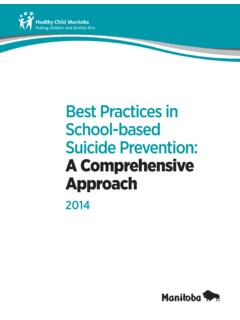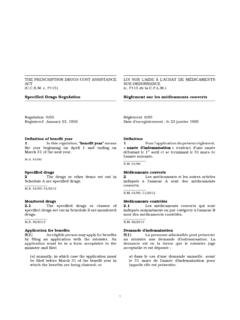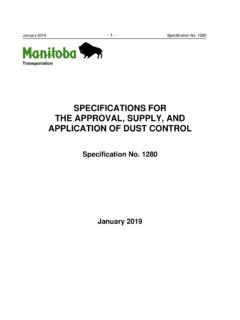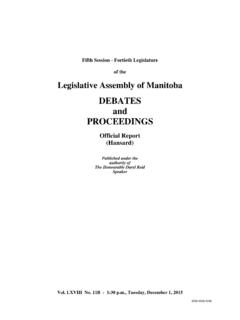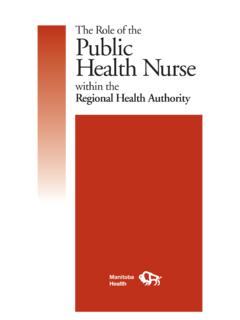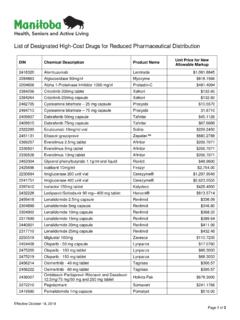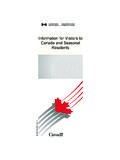Transcription of Preventing the Transmission of Infection in Health …
1 Routine Practices and Additional Precautions: Preventing the Transmission of Infection in Health Care April 2012. i Table of Contents Manitoba Guidelines for Routine Practices and Additional Precautions: Preventing the Transmission of Infection in Health 1. Introductory 1. 2. 3. Part A Overview of Routine Practices and Additional 14. I. 14. A. Principles upon which this Document is 15. B. Routine 16. C. Additional 16. D. Changing Populations and Health Care Delivery 16. E. Burden of Health Care Associated 17. F. Balancing Risk and Benefit in Preventing 18. II. Principles of Transmission of 19. A. Chain of 19. 1. Infectious Agents (Microorganisms).. 19. 2. Reservoirs in Health 19.
2 3. Routes of 20. 4. Portals of 20. 5. Portals of 20. 6. Susceptible 20. B. Sources or Reservoirs of Infectious Agents (Microorganisms).. 20. 1. Human 20. 2. Animal 20. 3. Environmental 20. Table 1: Examples of Environmental Sources of 21. C. Exposure to and Routes of Transmission of Infectious 21. 1. Exposure to Infectious Agents (microorganisms).. 21. 2. Routes of 22. D. Host 25. E. Outcomes of Transmission of Infectious Agents (Microorganisms).. 25. 1. 25. 2. Asymptomatic Infection /Clinical 26. III. Control Measures to Reduce Health Care Worker Exposure to and Transmission of 26. A. Hierarchy of Controls to Reduce Exposure to and Transmission of Infectious 26. 1. Engineering 26.
3 2. Administrative 26. 3. Personal Protective 26. Table 2: Examples of Control Measures According to Hierarchy of 27. B. Organizational Responsibilities to Reduce Exposure to and Transmission of Infectious 28. 1. Organizational Risk Assessment (ORA).. 28. 2. Organizational Control 28. Engineering 28. 3. Administrative Control 30. C. Health Care Worker 34. 1. Point of Care Risk 34. ii Table of Contents Table 3: Variables (risk factors) Influencing Transmission Risk using C. difficile as an Example of Contact 36. Table 4. Variables (risk factors) influencing Transmission risk using seasonal influenza as an example of droplet 37. 2. Health Care Worker Control Measures to Reduce Exposure to and Transmission of Infectious 38.
4 Part B Recommendations for Routine Practices and Additional 45 Organizational 45. II. Health Care Worker 47. III. Recommendations for Routine Practices in all Health Care 48. 1. Point of Care Risk 48. 2. Hand 48. 3. Source 48. 4. Patient Placement and 49. 5. Patient 50. 6. Aseptic 50. 7. Use of Personal Protective 51. 8. Sharps Safety and Prevention of Exposure to Bloodborne 53. 9. Cleaning and Disinfection of Non-Critical Patient Care 54. 10. Environmental 54. 11. Handling of Deceased 55. 12. Handling of Linen, Waste, Dishes and 55. 13. Education of Patients, Families and 55. 14. Visitor 55. IV. Recommendations for Additional Precautions in All Health Care Settings and Modifications for Precautions in Specific Health Care 56.
5 Sub-section (i) Contact Precautions for ALL Care 56. 1. Source 56. 2. Patient Accommodation and 56. 3. Patient 57. 4. Personal Protective 57. 5. Cleaning and Disinfection of Non-Critical Patient Care 57. 6. Cleaning of the Patient 58. 7. Education of Patients, Families and 8. Management of 9. Duration of 10. Handling of Deceased 11. Waste, Laundry, Dishes and 12. Modifications for Contact Precautions for Long Term Care, Ambulatory Care, Home Care, Sub-section (ii) Droplet Precautions in ALL Care 61. 1. Source 61. 2. Personnel 61. 3. Patient Placement and 61. 4. Patient 62. 5. Use of Personal Protective 62. 6. Cleaning of Patient Care 62. iii Table of Contents 7. Cleaning of Patient 62.
6 8. Education of Patient and 62. 9. Management of 63. 10. Duration of 63. 11. Handling Deceased 63. 12. Waste, Laundry, Dishes and 63. 13. Modifications for Long Term Care, Ambulatory Care, Home Care, Prehospital 63. Sub-section (iii) Airborne Precautions in All Care 64. 1. Source 64. 2. Patient Placement and 65. 3. Patient 65. 4. 65. 5. Management of Case Patients with Airborne 66. 6. Management of Exposed Susceptible Roommates and Other Close 66. 7. Personal Protective 66. 8. Management of Patient Care 67. 9. Cleaning of Patient 67. 10. Education of Patient, Family and 67. 11. Management of 67. 12. Duration of 68. 13. Handling of Deceased 68. 14. Upon Discharge or Discontinuation of Airborne 68.
7 PART 70. Table 5 Transmission Characteristics and Empiric 70. PART 79. Table 6 Transmission Characteristics and Precautions by Specific 79. Appendix I Epidemiologically Significant 110. 1. Clostridium 110. 2. Antimicrobial Resistant 111. 3. Viral 113. 4. Emerging Respiratory 113. Appendix II Terminal 114. Appendix III Air Changes Per Hour and Time in 115. Appendix IV Technique for Putting On and Taking off 116. Appendix V Elements that Comprise Contact 118. Appendix VI Elements that Comprise Droplet 119. Appendix VII: Elements That Comprise Airborne 120. Appendix VIII: Elements That Comprise Droplet and Contact Precautions for Acute Respiratory 121. 122. 1. Introductory Statement Manitoba Health develops Provincial Infection The guiding principles used in developing these Prevention and Control Guidelines to provide guidelines included: evidence-based recommendations based on guidance- 1.
8 To respond to current challenges in limiting based recommendations from the national level, The Transmission of Infection within Health care Public Health Agency of Canada (PHAC) and the settings. international level, such as the Centres for Disease Control and Prevention (CDC) and Health Care 2. To reaffirm Routine Practices as the foundation Infection Control Practice Advisory Committee for Preventing the Transmission of microorganisms (HICPAC). during patient/ client/resident care in all Health care settings. Information for these guidelines was gathered from professionals in Manitoba Health , Manitoba 3. To update the appropriate use, when required, Labour and Immigration, Winnipeg Regional Additional Precautions in addition to Routine Health Authority, the University of Manitoba and Practices.
9 Health Sciences Centre. The principle source for this 4. To provide evidence based and best practice guideline is the PHAC document of similar title, with recommendations. modifications appropriate to use in Manitoba. This guideline, whenever possible, has been based on Although not regulatory in scope, these guidelines may research findings. Where there is insufficient published assist in standardizing Infection Prevention and Control research, consensus by experts in the field has been used practices throughout the province. Regional Health to provide recommendations for specific practices. Authorities (RHAs) are expected to develop regional The information in this guideline was current at policies and procedures based on these guidelines.
10 The time of publication. Scientific knowledge and The purpose of this Guideline Routine Practices technology are constantly evolving. Research and and Additional Precautions for Preventing the revisions of these guidelines will be necessary as Transmission of Infection in Health Care is to provide advances in the field develop. a framework for development of policy and procedures Although the guidelines will be updated periodically, to ensure that Routine Practices and Additional practitioners are responsible for ensuring that the most Precaution are effectively used. recent knowledge is applied for each case. 2. Abbreviations ABHR(s) Alcohol-based hand rub(s). AIIR(s) Airborne Infection isolation room(s).

